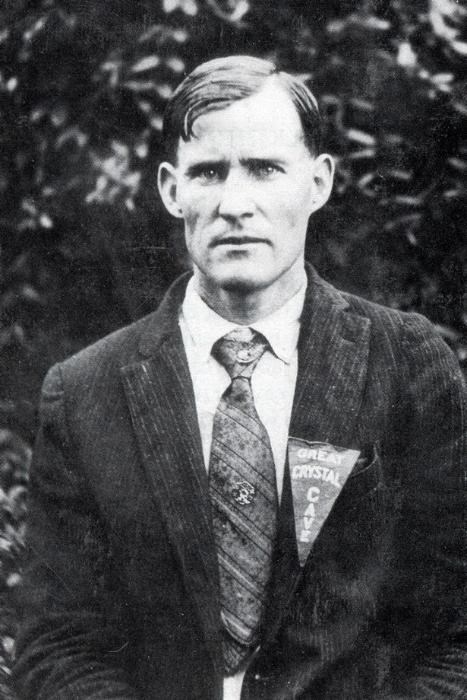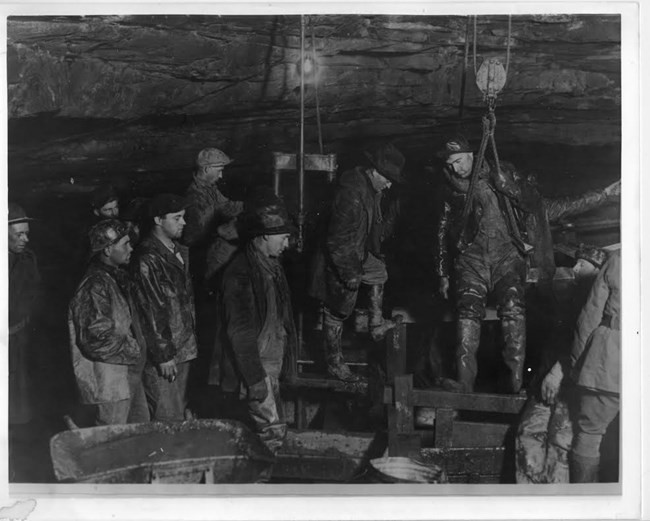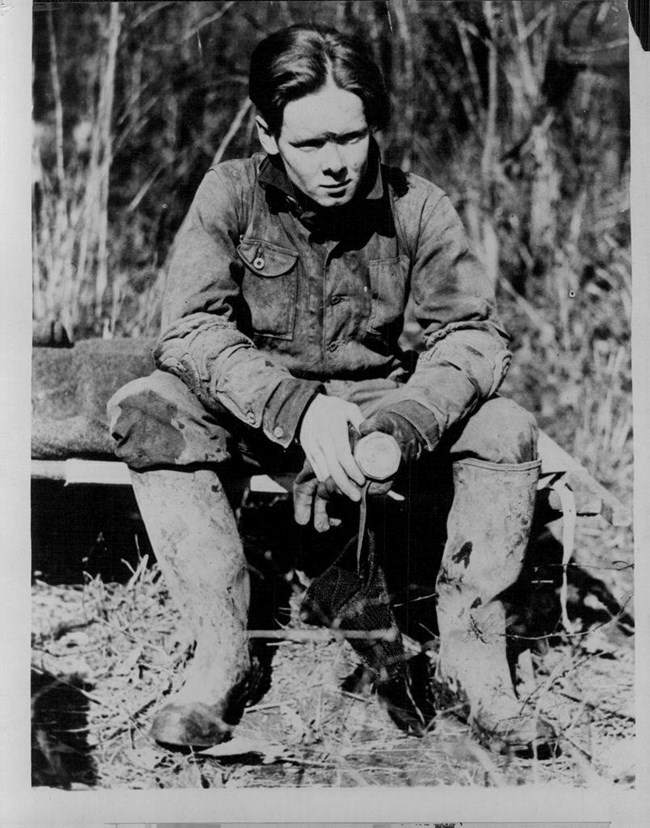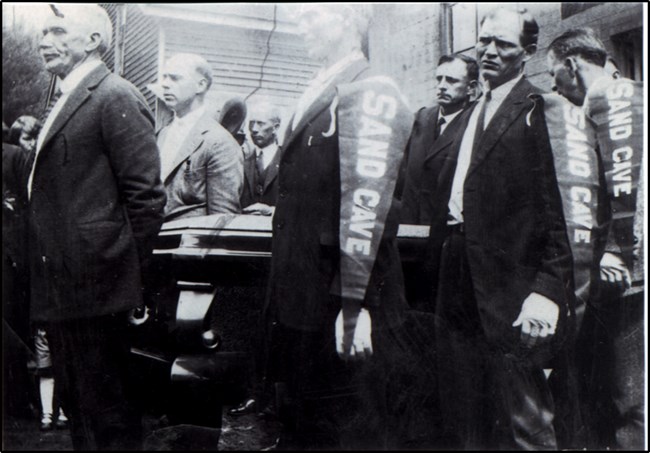Last updated: July 16, 2025
Article
Tragedy at Sand Cave

Floyd Collins' Crystal Cave
William Floyd Collins, better known as Floyd Collins, was born July 20, 1887 in Logan County, Kentucky to Lee Collins and Martha Jane Burnett. From an early age, Floyd developed a hobby of exploring caves. This pastime led to the discovery of Crystal Cave in 1917 beneath his father’s farmland. Floyd developed the cave into a tourist attraction that boasted unique helictite and gypsum cave formations.
During Floyd’s time, cave tourism was a lucrative and very competitive business. Due to aggressive and highly suspicious practices between rival cave owners, this era became known as the “Cave Wars.”
Great Crystal Cave made little to no profit due to its remote location along the Flint Ridge Road. Visitors had to pass by many other show caves offering similar enticing views, and they rarely made the extra effort to journey to Crystal Cave.
Sand Cave
Floyd knew of another potential cave located on property owned by Beesly Doyel. This cave, known as Sand Cave, had prime real estate situated right beside Cave City Road. Travelers would easily pass by Sand Cave before continuing to the other show caves such as Mammoth Cave. Floyd entered into an agreement with Beesly Doyel to explore Sand Cave and share the profits if the cave proved worthy to show
Floyd first entered Sand Cave on January 30, 1925 with only a single kerosene lantern and shortly found it offered many challenges. He found himself squeezing through tight passageways – at one point so tight that he had to inch through on his stomach, with one arm stretched out ahead of him, pushing his lantern, and the other arm at his side. Beyond this crawl, the cave began to open up, but his lantern suddenly began to flicker.
Floyd knew the peril of losing light in a cave, so he reluctantly began his return journey. As he returned through the tight crawl, his foot dislodged a 27-pound rock which wedged his ankle in place. Try as he might in his awkward position he could not remove his foot. He was trapped in a stone straight-jacket. Thus begun Floyd’s harrowing tale in Sand Cave.

The Rescue Efforts
Once it was discovered that Floyd was trapped in the cave, rescue efforts slowly ramped up. Engineers, geologists, and cavers were called in from all over the local area and state. When more conventional means failed, miners began digging a shaft to reach him. Rescuers worked long hours day and night in hopes of finding a solution to getting Floyd unstuck from Sand Cave. The workers encountered periods of rain and cold weather, cave collapses and disagreements among leaders on how to proceed. The rescue efforts spanned over 17 days with many tactics to rescue Floyd attempted, but all of them ultimately failing.

All Eyes on Sand Cave
Throughout the rescue efforts, the story became too big for Cave City. People began to arrive from all parts of the country and a "carnival atmosphere" took hold at the mouth of Sand Cave. Vendors appeared, selling food, drink and souvenirs. Thousands of sightseers descended on Cave City, and the state was forced to dispatch troops to keep order.
Reporters came from all over as the news of Floyd Collins entrapment became a national story. The most notable of these reporters was Willam Burke Miller, called "Skeets" because he was "not much bigger than a mosquito." Skeets Miller made several daring trips into Sand Cave to interview Floyd, interviews which would later earn him the Pulitzer Prize.
A Tragic End
On the eighteenth day after his entrapment, rescuer’s finally reached Floyd via a 55 ft. vertical shaft, but it was too late. Floyd Collins was pronounced dead of exposure, and Sand Cave was sealed with Floyd’s body inside. Only months later would his body be removed for a formal burial closer to his family’s home near Crystal Cave. He now rests in the Mammoth Cave Baptist Church Cemetery.

The Story Lived On
The life of Floyd Collins and the tragic events surrounding his death captivated the attention of the country and brought many changes upon the rural community in southcentral Kentucky that is home to Mammoth Cave. His story would later go on to inspire books such as Trapped! written by Robert K. Murray & Roger W. Brucker, and The Life and Death of Floyd Collins written by Floyd’s brother Homer Collins & John L. Lehrberger. It was the inspiration for a world toured musical, Floyd Collins, and the 1951 Hollywood film Ace in the Hole. More importantly, the life and death of Floyd Collins drew the nation’s attention to Kentucky's cave country and the desire to protect it, eventually leading to the establishment of Mammoth Cave National Park in 1941.
Timeline of Floyd Collin’s Entrapment
Floyd Collins enters Sand Cave in the morning.
Upon exiting the cave, he dislodges a 27-pound rock that falls and pins his ankle. In his attempt to free himself he ends up burying himself up to his waist in rubble.
Floyd is trapped 60 feet beneath the earth’s surface.
Neighbors realize that Floyd did not come home the previous night and go out to look for him.
They discover his coat hanging outside Sand Cave and proceed to search for him.
The cave passageways are so tight that only a 17 year old boy (Jewell Estes) crawls back far enough to communicate with Floyd, thus discovering he was trapped.
Neighbors alert Floyd’s family and soon his brothers, Homer and Marshall, join the rescue attempt. They start by bringing Floyd food and water.
Homer attempts to dig Floyd free with little success.
Many locals start gathering around the entrance to Sand Cave to see what is happening with Floyd.
Marshall offers $500 to whoever can free his brother, but still no volunteers.
The rescue efforts are disorganized and chaotic, no leader is appointed and no one idea of rescue is identified.
Many volunteers agree to bring food and drink down to Floyd but get scared in the tight, dark passageways. They, instead stash the items in cracks and crevices and never get the provisions to Floyd.
Floyd Collins is in rough shape. He is cold, shaky, numb, and experiences periods of both stupor and lucidity.
News that a man in Kentucky is trapped in a cave begins to spread around the region and state.
A journalist from the Louisville Courier-Journal named William “Skeets” Miller heads to Cave City to check out the story. Upon arriving and asking Homer about the situation, Homer says “if you want information, there’s the hole right over there. You can go down and find out for yourself.”
Skeets Miller enters Sand Cave to speak to Floyd.
Upon seeing the situation Floyd is in, Skeets forgets about the news story and starts assisting in the rescue attempt.
Lieutenant Robert Burdon (Special Police-Fire Rescue Team) arrives on scene and attempts to free Floyd by using a harness around his chest to pull him out. This attempt is painful and unsuccessful.
Roughly 200 people are gathered outside the cave. Two tents have been erected, one to sell hot coffee and snacks and the other for first-aid.
John Gerald (caving buddy of Floyd Collins) arrives on scene and joins the rescue attempts by trying to dig him out.
Floyd Collins becomes the top news story in the nation.
Three men from the Woodson and Kratch Monument Co. of Louisville arrive and try to convince John Gerald to let them chisel away at the rock above Floyd. John Gerald is concerned this would lead to more harm than good and refuses to let them try. This causes a rift in the people trying to free Floyd.
Henry St. George Tucker Carmichael (Superintendent of Kentucky Rock Asphalt Company) arrives with his workers. He makes the first attempt at an organized and coordinated rescue. He starts scouting out a rescue shaft location but Floyd’s brothers and the locals are convinced that the rescue shaft would jar the rocks and cause a collapse, killing Floyd. Carmichael reluctantly agrees and has his men start removing rocks from the cave passageway to make further cave rescue attempts easier.
Skeets and other volunteers rig an electrical drop cord with several light bulbs to a 32 volt generator. They string these lights through the cave to Floyd so he can have light and warmth in the cave.
The National Guard arrives to assist with crowd control.
Lieutenant Robert Burdon returns and wants to attempt another pulling scheme. He is intent on bringing Floyd out of the cave with or without his foot. John Gerald and Robert Burdon get into a large fight about the best plan of action.
Most of the rubble has been removed from Floyd’s body and the idea of using jacks to prop the rock that trapped his foot is being discussed. Skeets tries this method and the first two jacks are too big and the last one is too small. They use wooden blocks to prop up the small jack but it continues to slip. Sweaty and exhausted Skeets becomes very frustrated and Floyd convinces him to go get some rest and come back and try again in the morning.
Tension between the locals and the outsiders (those coming from outside of the community to help) are high. Eventually, everyone decides to get some rest and start back again in the morning.
Early morning; Floyd is in decent shape.
The jack idea is seen as the best attempt so it is decided to try again. Lieutenant Robert Burdon holds a press conference in the early morning hours stating that they are very hopeful to have Floyd out of the cave very soon.
The ceiling of the cave is starting to show signs of crumbling and the passageway is unstable. John Gerald is worried so many people coming and going from the cave, rubbing against the walls and adding their body heat will give rise to the chance of a collapse. Lieutenant Robert Burdon and Skeets Miller try to reassure him nothing bad will happen but they are seen as “outsiders” or people not familiar with the area or caves in general.
4:00am: two gentlemen enter Sand Cave to give Floyd food and notice the passageway and ceiling has developed large cracks. Sizeable rocks are slumping downward and debris is falling. They hurry to exit the cave as rocks start to fall. There is officially a cave collapse that separates the rescue teams from Floyd Collins.
Several of the rescuers deem the Sand Cave passageway is useless and dangerous. No more attempts to free Collins will be made via this route.
John Gerald makes an attempt to dig out the collapse with a select group of men. They will shore up the sides of the cave as they go, but due to several days of rain, , rubbing of the walls by rescuers, a midwinter thaw, and dripping ground water, the cave structure deteriorates further creating another collapse in the passageway. In an attempt to get through the second collapse, several rocks fall on Gerald in his rescue attempt causing him to finally leave the cave admitting defeat.
The rescuers are truly feeling defeated.
Churches across the country are holding services for Floyd Collins.
Floyd is the top news story in the New York Times. The interviews with Floyd that Skeets Miller provides become incredibly popular.
The Governor of Kentucky, William J. Fields places National Guard Brigadier General Henry Denhart in command of the rescue. .
Engineer Henry Carmichael supervises the creation of a 6’x6’ vertical shaft to rescue Floyd.
General Denhart states “It is now up to you men to drill through the ground directly to Collin’s side. Spare no expense. The purse strings of Kentucky are open.”
Due to lengthy deliberations on where to place the shaft, the project does not get underway until 1:30pm. The use of drills, dynamite, power shovels, pneumatic drills are excluded from the rescue attempt due to the fear that it will cause the cave to collapse and kill Floyd. The only tools allowed are picks and shovels.
Many companies and business from all over the country start sending supplies to Sand Cave which is quickly becoming overloaded with items.
By nightfall there is a work force of 75 men working round the clock to dig the rescue shaft.
Carmichael predicts it would take them 30 hours to reach Floyd. (A digging rate of 2 feet per hour).
For the first four or five feet the diggers encounter nothing but mud and muck. The next several feet are mixed rock and the shaft is only big enough for 3 people to work at a time. By 7:00pm they are seven feet down with a digging rate of only one foot an hour.
A hospital is set up to treat people for cuts, colds, contusions, bruises, and physical exhaustion.
Locals are pushed out of the rescue area and are not happy about it.
Floyd has officially been trapped in Sand Cave for a week.
Work on the shaft progresses at a snail’s pace.
Reporters are pestering many people trying to get information on Floyd.
Massive amounts of volunteers and supplies arrive to work on the shaft. The process is well organized and managed but due to large rocks, gravel, and muck in the shaft it slows progress.
The shaft has reached 17 feet in depth.
Due to rising tempers and many arguments, Homer Collins and Johnnie Gerald are banned from the rescue site.
400 automobiles jam the roads trying to get to Sand Cave.
Several motion picture crews arrive on site, hoping to capture the drama unfolding.
Rumors and lies start to spread as the newsman become desperate for anything to write/broadcast about.
National Guard erects a barb-wired fence to secure the rescue site.
National Red Cross arrives and takes over feeding the workers. It is stated that previously the workers only had “black coffee, crackers, and moonshine whisky.”
Several people look for other caves or entrances to Sand Cave to possibly gain access to Floyd from another passageway. This is unsuccessful.
Cave City is inundated with visitors and news people. There is a newsman from every state in the Union and some foreign reporters present as well. An English correspondent makes the first trans-Atlantic phone call ever handled in Cave City.
Named “Carnival Sunday” as an estimated 10,000 descend upon Sand Cave in hopes to see rescuers pull Floyd Collins out. The area takes on a carnival like atmosphere with food services, entertainment and booze.
By 1:00pm the shaft is 23 feet deep
By nightfall it is estimated that 4,500 automobiles have been to the Sand Cave area and bare license plates from 20 different states.
Accusations that not enough was done in the beginning to save Floyd begin to be printed in the newspapers and people start pointing fingers at who is to blame. Robert Burdon goes as far as to say that some of the “rescuers” were “guilty of nothing short of murder.” Rumors are flying that this is all a publicity stunt to get people to come to Floyd’s Great Crystal Cave and that he isn’t even trapped down there. All of the various rumors have to do with jealousy, personal enmity, and commercial strife. The stories printed in the newspaper cause the police to step in and order a grand jury investigation into the legitimacy of these statements.
The media starts to paint the entire scene in a very negative light. Four main theories are floating around:
It is a colossal hoax to lure tourists to Kentucky’s Cave Country.
Collins was murdered by someone unknown after he entered the cave.
Food and water are purposely being withheld from him so he will die.
Collins is still alive and travels out of the cave and back each night.
A Military Court of inquiry convenes in Cave City to clear up any suspicions of criminal activity to block the rescue attempts and to disprove rumors that Floyd’s entrapment is a hoax.
Volunteer numbers drop as people begin to think the events at Sand Cave are an elaborate hoax.
Rain slows progress on the rescue shaft.
As a cold front moves in, snow begins to fall.
Temperature fall to the 20’s.
Numb hands and cold feet slow the progress on the shaft.
The court case continues to hear testimony in Cave City.
Floyd has been trapped for 13 days and has not eaten in over a week.
Rescue shaft has reached 48 feet and the sides need constant shoring to avoid collapse.
The court case makes a trip to the cave to get testimony from more people.
Rumors spread that Floyd was rescued and Washington D.C. became so inundated with calls that business is suspended for the day to deal with the situation.
At 10:00pm the shaft reaches 52 feet.
The shaft is now 55 feet and the sides are starting to slump. They are desperate to reach Floyd so they decide to start digging laterally to reach him faster.
There has been heavy rain and there is 2 feet of standing water at the bottom of the shaft that needs to be pumped out.
Dismal rain and fog continue to plague the Cave City area.
It is estimated that roughly 5,000 people traveled to Sand Cave to watch the rescue efforts.
By the end of the night the lateral tunnel is within several feet of Floyd. Everyone waits with baited breath to see them pull Floyd Collins out.
At 1:30pm they break through to a Sand Cave passage.
Floyd Collins is found dead. They say the cause of death is due to exposure, exhaustion and starvation. Due to the condition of his body he has been dead for over 24 hours.
Due to the fact that Floyd’s leg was still trapped they decided to leave his body in Sand Cave and abandon the rescue shaft as it was slumping at an alarming rate. They didn’t want to risk any more lives.
